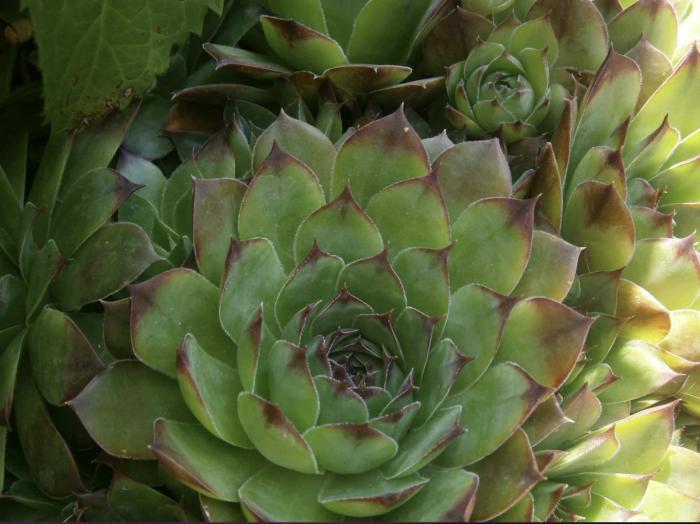Sempervivum tectorum
Hens and chicks, houseleek, roof ho

Description
Sempervivum tectorum is a low-growing evergreen succulent that looks a little like rubbery roses with thick, fleshy pads arranged in rosettes. The leaves are usually pointed and some have purple tips or they may grow in shades of red. They are considered alpine or rock garden plants, because of their hardiness and drought resistance. The original hen rosette produces tiny rosette offsets known as the chicks. They are slow-growing plants, and they remain evergreen throughout the year, even in cold climates. Mature plants produce an odd-looking thick flower stalk with star-shaped flowers at the tip of mauve-pink or red. These are not tall plants, except when they stretch out to flower. The flower stalk extends 8 to 12 inches before flowering, then reduces in size once the plant blooms and the mother plant dies. Hens and chicks are not grown for their flowers, but when they do bloom, it is usually during the summer. Plant them in late spring, when there's no longer a chance of frost and it's still not too hot outside. Planting a large patch, using them along edges, or mixing them in a container garden will help them stand out. Another option is to mix hens and chicks with creeping sedum which can make a lawn alternative where there is no foot traffic. If you have a rock garden or rock wall, you have the perfect environment for growing hens and chicks. Tuck them into the crevices or let them drape over a rock wall. Stone provides the perfect balance of drainage, radiant heat, and root protection. Hens and chicks will spread by underground roots. During the growing season, expect each plant to multiply itself by at least four, by producing little offset plantlets all around the perimeter of the hen. These chicks can be snapped off and replanted elsewhere at any time. Once established, the maintenance of hens and chicks is minimal. You’ll need to remove the old hens, after they flower, and divide chicks as needed. They are tough plants that survive just about any condition, even frost and cold. Hens and chicks prefer a spot in full sun but will appreciate some afternoon shade if planted in extremely hot climates. Hens and chicks, as with most succulents, need excellent drainage. Poor, sandy soil would be just fine. You could work some peat into heavier soil, to lighten it and improve drainage. Soil pH should be in the neutral range, 6.6 to 7.5. Except in extremely hot, dry situations, you won’t need to give this plant any supplemental water. They prefer an average climate between 65 and 75 degrees Fahrenheit. If temperatures drop too low, they will not necessarily die off but will stop growing and go into a semi-dormant state. No fertilizer is needed.
Plant Type
Succulent
Height Range
Under 1'
Width Range
Flower Color
Pink, Purple, Red
Flower Season
Summer
Leaf Color
Green, Purple, Red, Variegated
Bark Color
n/a
Fruit Color
n/a
Fruit Season
n/a
Sun
Full, Half
Water
Low
Growth Rate
Moderate
Soil Type
Sandy
Soil Condition
Well-drained, Dry
Soil pH
Neutral
Adverse Factors
n/a
Design Styles
Meadow, Mediterranean, Ranch, Spanish
Accenting Features
Unusual Foliage, Unusual Shape
Seasonal Interest
Winter, Spring, Summer, Fall
Location Uses
Entry, Patio, Walkways, With Rocks
Special Uses
Container, Filler, Mass Planting, Hanging Baskets
Attracts Wildlife
n/a
Water Saving Tip:
Fix leaking sprinklers, valves, and pipes.
One broken spray sprinkler can waste 10 gallons per minute - or 100 gallons in a typical 10 minute watering cycle.